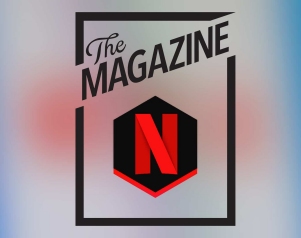
Reverse Publishing – The Hottest Trend in HollywoodWith Netflix joining the long list of digital brands using print, the phenomenon of 'reverse publishing' is one of the biggest developments in brand content.  By delivering a traditional magazine to the Hollywood community instead of a digital-only campaign, Netflix are looking to forge a deeper connection, as well as offering a physical object that acts as a permanent reminder of the brand and its programmes.
By delivering a traditional magazine to the Hollywood community instead of a digital-only campaign, Netflix are looking to forge a deeper connection, as well as offering a physical object that acts as a permanent reminder of the brand and its programmes.
By Sam Upton May 16, 2019 (Two Sides) - The latest digital brand turning to print to reach a new audience has been announced as Netflix. With a market value of $21.2bn and a global user base of 150m, the streaming service hasn't had to do a great deal of marketing – print or digital – instead preferring to plough much of its profits into making its own content. So the launch of its own magazine has come as a bit of a surprise. With a working title of Wide, the 100-page publication will include features, interviews and articles about Netflix-produced content, focusing on the people that create it. But rather than targeting its millions of users, the magazine is aimed at the highly competitive Hollywood awards community, promoting its shows and stars in the middle of voting season for the upcoming Emmys. “Netflix has spent hundreds of millions of dollars in pursuit of Hollywood awards,” writes Lucas Shaw in Bloomberg, “which help burnish the image of the streaming service's still-young studio in the eyes of consumers and the entertainment industry.” Influencing the influencersThis new marketing gambit aims to use a print magazine to provide a crucial point of difference when it comes to influencing an extremely hard-to-influence audience. By delivering a traditional magazine to the Hollywood community instead of a digital-only campaign, Netflix are looking to forge a deeper connection, as well as offering a physical object that acts as a permanent reminder of the brand and its programmes. “In preparation for a groundbreaking year in film and television,” the brand wrote in a promotional message, “Netflix has gathered some of the most talented and sought-after writers and photographers, thinkers and creatives, to make the inaugural issue of Wide, the Netflix print journal.” A developing trendThe curious phenomenon of digital companies using print to reach a certain audience or add gravitas to a message has been around for a while now. Shame-faced brands will often use the respectability and permanence of newspapers to let the world know they're sorry for a corporate transgression – see Facebook's apology for the Cambridge Analytica scandal or KFC apologising for running out of chicken. Direct mail also holds an appeal for the online giants, particularly when it comes to reaching hard-to-reach contacts, such as company CEOs. Google and LinkedIn have both used well-crafted, creative mailers that have enough creativity to get past the office gatekeepers and land on the desks of company bosses around the globe. Then there's Amazon, who released a print catalogue last year to promote their toy range for Christmas, and Apple, who regularly use the world's top fashion magazines to launch their new phones, linking their product with style, elegance and desirability. The attention economyWhat Apple, Google, Facebook, Netflix, Amazon, LinkedIn, Airbnb, and the many other brands that have built their fortunes on the back of digital know, is that print offers an entirely different experience to online. That experience not only gives the reader time and space to enjoy the content, free of distraction and the compulsion to move onto the next story, but offers a longer read and a chance to delve deep into a subject to gain a better understanding. Whether that subject is a Hollywood director or a cute B&B just outside Barcelona, a stronger bond is created between magazine and reader, and by extension, the brand. In a world overloaded with content, many companies are realising that their digital-only marketing strategies need to change if they are going to retain their customers' attention and loyalty. And right now, the medium that's getting the attention is print. Editor's Note: Sam Upton is Founder and Editorial Director of Soul Content. This article was published on Two Sides website: www.twosides.info Two Sides was created in 2008 with members from the graphic communications supply chain, creating a forum for the industry to work together and share experiences; improving standards and practices; maximising customer confidence in our products. SOURCE: Two Sides |